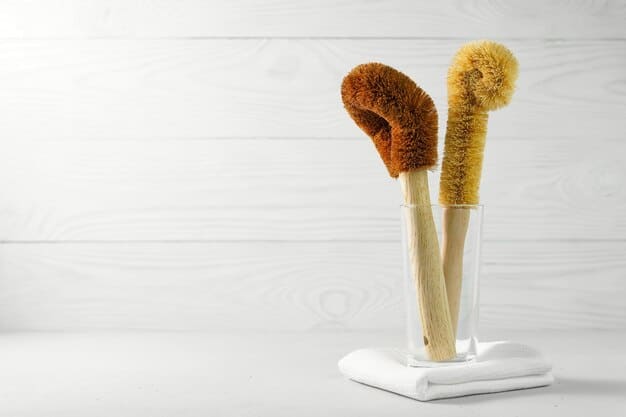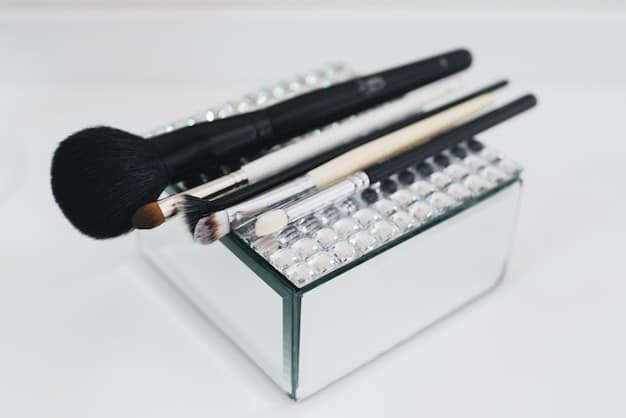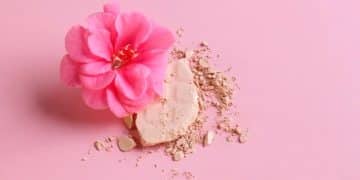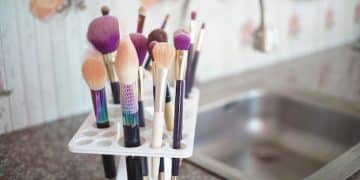How to Clean Your Makeup Brushes: A 2025 Step-by-Step Guide

Cleaning your makeup brushes regularly is crucial for maintaining skin health and extending brush lifespan, a practice made simple with effective, step-by-step methods evolving for 2025 to ensure proper hygiene and application.
In the evolving landscape of beauty, where innovation meets necessity, understanding How to Clean Your Makeup Brushes: A Step-by-Step Guide for 2025 is more critical than ever. Far from a mere chore, regular brush cleaning is a foundational pillar of skincare and makeup artistry, directly impacting not only the longevity of your tools but, more importantly, the health of your skin and the flawless application of your products.
The Pivotal Role of Clean Brushes in 2025’s Beauty Regime
The beauty industry consistently innovates, introducing new formulas and application techniques. Yet, one fundamental aspect remains constant: the importance of impeccable hygiene, especially when it comes to tools that directly interact with your skin. Makeup brushes, often overlooked, are prime real estate for bacteria, oil, and old product buildup.
Neglecting brush cleaning can lead to a plethora of skin issues, ranging from frustrating breakouts to more severe infections. Furthermore, dirty brushes compromise makeup application, leading to streaky finishes, muddy colors, and reduced product payoff.
Why Clean Brushes are Non-Negotiable
Regularly cleaning your brushes ensures you are not inadvertently spreading germs onto your face. Each time a brush touches your skin, it picks up natural oils, dead skin cells, and bacteria. Without proper cleaning, these undesirable elements are redeposited with every subsequent application.
Consider the delicate balance of your skin’s microbiome. Introducing foreign bacteria repeatedly can disrupt this balance, leading to irritation, clogged pores, and a compromised skin barrier. Clean brushes significantly reduce this risk.
- Prevents bacterial buildup and breakouts.
- Extends the life of your expensive makeup brushes.
- Ensures smooth, even makeup application.
- Maintains true color payoff of your makeup products.
Beyond hygiene, clean brushes perform better. They allow for seamless blending, precise application, and a professional finish, which is paramount in 2025’s increasingly sophisticated beauty standards. Investing in quality makeup brushes is only half the battle; maintaining them is the other, equally important half.
Ultimately, making brush cleaning a routine practice is an act of self-care. It safeguards your skin’s health, preserves your beauty investments, and elevates your makeup experience. In an era where conscious beauty reigns supreme, the ritual of cleaning your brushes stands as a testament to mindful self-care.
Choosing the Right Cleaning Products and Tools
With an array of brush cleaning products available in 2025, from specialized shampoos to quick-drying sprays, selecting the right arsenal can seem daunting. The key lies in understanding your brush type and specific needs, marrying efficacy with gentle care to preserve your brushes’ integrity.
Different brush materials—synthetic versus natural hair—require slightly varied cleaning approaches. Synthetic bristles, often found in liquid and cream makeup brushes, are generally more resilient and easier to clean. Natural hair brushes, typically used for powder products, are more porous and can be more delicate, needing gentler formulas.
Cleansers for Deep Cleans
For a thorough reset, especially when brushes are heavily soiled, a dedicated brush shampoo or gentle soap is ideal. Many brands now offer antimicrobial formulas that not only clean but also disinfect, offering an added layer of protection against bacteria.
- Dedicated Brush Shampoos: Formulated to break down makeup residues without stripping or damaging brush fibers. Look for options labeled “anti-bacterial” or “conditioning.”
- Gentle Bar Soaps: Unscented glycerin soaps or even baby shampoo can be effective and economical alternatives. Ensure they don’t contain harsh detergents or strong perfumes.
- Solid Brush Cleansers: Compact and convenient, these often come in a pot, allowing you to swirl the brush directly onto the solid soap for quick lathering.
When selecting a deep cleanser, consider ingredients. Avoid products with excessive alcohol, harsh chemicals, or synthetic dyes, which can dry out bristles or degrade their adhesive over time. Opt for gentle, pH-balanced formulas that rinse easily and leave brushes soft.
Tools for Effective Cleaning
While soap and water are the primary agents, certain tools can significantly enhance the cleaning process, making it faster and more effective. These tools are designed to create friction, dislodging stubborn makeup without damaging the bristles.

- Silicone Brush Cleaning Mats or Gloves: These feature textured surfaces that help work the cleanser into the bristles, effectively removing makeup residue. They come in various patterns, each designed to tackle different brush shapes and sizes.
- Brush Drying Racks: Essential for maintaining brush shape and preventing water from seeping into the ferrule (the metal part connecting bristles to the handle). Drying brushes upside down or horizontally allows water to drain away, preventing damage to the glue and promoting even drying.
- Microfiber Towels: Soft and absorbent, these are great for gently squeezing out excess water post-rinse and for reshaping bristles before drying.
Many brands now offer comprehensive cleaning kits that include a cleanser, a mat, and a drying rack, providing a convenient all-in-one solution. These kits are often more cost-effective than purchasing individual items and ensure compatibility between products.
Regardless of your chosen products, always read the instructions carefully. Some specific cleansers might have unique application methods or drying recommendations. The goal is to clean thoroughly yet gently, preserving your valuable tools for countless flawless applications.
Step-by-Step Guide to Deep Cleaning Your Brushes
A thorough deep clean is the cornerstone of brush maintenance, recommended weekly for heavily used brushes and bi-weekly for others. This process ensures the removal of all makeup, oils, and bacteria, restoring your brushes to their pristine condition.
The method involves a sequence of wetting, lathering, rinsing, and drying, each step crucial for optimal results. Consistency in this routine significantly impacts both brush longevity and skin health.
Preparing for the Cleanse
Before you begin, gather all your brushes, your chosen cleanser, a silicone cleaning mat (if using), and clean towels. Dedicate a space, ideally near a sink, where you can comfortably work without splashing water on other items.
Separate your brushes by type if you have many, perhaps grouping face brushes (foundation, powder) and eye brushes (shadow, eyeliner) together. This can streamline the process, especially if using different cleansers for various bristle types.
- Gather all necessary supplies: brushes, cleanser, cleaning mat/glove, towels.
- Clear a workspace, preferably a sink area.
- Organize brushes by type or size for efficiency.
Having everything within reach minimizes interruptions and ensures a smooth, efficient cleaning session. Ensure your water source has a consistent flow and temperature, ideally lukewarm, as hot water can degrade brush adhesives and damage bristles.
The Cleaning Process
The actual cleaning involves several distinct steps, each designed to progressively remove impurities without damaging the brush. Patience and a gentle hand are key to preserving the integrity and shape of your bristles.
Start by wetting the brush bristles under lukewarm running water, pointing the brush downwards to prevent water from entering the ferrule. Apply a small amount of cleanser directly onto the bristles or onto your cleaning mat.
Gently swirl the brush on the textured mat or in the palm of your hand, encouraging the cleanser to lather and lift away makeup residue. You’ll see the makeup color visibly leaving the brush. Continue swirling until the lather is clean and free of pigment.
Rinse the brush thoroughly under lukewarm running water, once again pointing the brush downwards. Continue rinsing until all traces of soap are gone and the water runs clear. Avoid submerging the entire brush handle in water, as this can weaken the glue.
Gently squeeze excess water from the bristles using your fingers or a clean microfiber towel. Reshape the brush head back to its original form. Pay attention to fluffier brushes that may splay out; reshape them carefully.
- Wet bristles downwards under lukewarm water.
- Apply cleanser and gently swirl on a textured mat or palm.
- Rinse thoroughly until water runs clear.
- Gently squeeze out excess water and reshape bristles.
This meticulous cleaning ensures that every strand is clean and free of residue, ready for its next use. The care taken during this process directly influences the longevity and performance of your makeup brushes.
Drying and Maintaining Your Brushes for Longevity
Post-cleaning care is as crucial as the cleaning itself. Improper drying can lead to mildew, bacterial growth, and permanent damage to your brushes. Proper drying ensures hygiene and preserves the brush’s shape and integrity, extending its life considerably.
The goal is to allow brushes to air dry completely, ideally in a position that prevents water from seeping into the ferrule and loosening the adhesive that holds the bristles to the handle. This is where brush drying racks become invaluable.
Optimal Drying Techniques
After reshaping your brushes, lay them flat on a clean, dry towel or, even better, hang them upside down in a brush drying rack. Hanging them downwards utilizes gravity to pull water away from the ferrule, preventing glue degradation and bristle shedding.
Ensure the brushes are well-ventilated and not in a humid environment. Avoid drying them upright in a cup or container, as this traps water at the base of the bristles, leading to mildew and weakening the brush structure. Also, avoid using direct heat sources like hair dryers, which can melt synthetic bristles or damage natural hair.
Allow ample time for brushes to dry completely, which can take anywhere from a few hours to overnight, depending on the brush’s density and prevailing humidity. Larger, denser brushes will naturally take longer to dry than smaller, fluffier ones.
- Lay brushes flat on a towel or hang them upside down in a drying rack.
- Ensure good ventilation and avoid humid environments.
- Never use direct heat sources or dry brushes upright.
- Allow sufficient time for complete air drying.
Once fully dry, gently fluff out the bristles with your fingers to ensure they are soft and ready for use. Ensuring complete dryness is critical to preventing bacterial growth and maintaining the brush’s quality.
Between-Washes Maintenance
While deep cleaning is essential, quick daily or weekly maintenance between washes can keep your brushes fresher for longer. This is particularly useful for brushes used frequently with liquid or cream products.
Daily spot cleaning involves using a quick-drying brush cleaning spray (often alcohol-based) after each use. Simply spritz the cleaner onto the bristles or a paper towel and gently wipe the brush back and forth until the color transfers onto the towel. This removes superficial makeup and helps disinfect.
For powder brushes, tapping off excess product on a tissue or a clean cloth after each use can significantly reduce buildup. This prevents product accumulation that can alter application and harbor bacteria.
- Use a quick-drying brush cleaning spray for daily spot cleans.
- Wipe powder brushes on a clean tissue after each use.
- Store brushes properly to prevent dust and grime accumulation.
Proper storage also plays a role in maintenance. Keep brushes in an upright cup, a brush roll, or a drawer to protect them from dust and physical damage. Ensure they are not exposed to open air for extended periods if you live in a dusty environment.
By integrating these drying and maintenance practices into your routine, you not only ensure your brushes are hygienically sound but also preserve their effectiveness and aesthetic quality for years to come.
Special Considerations for Different Brush Types
Not all makeup brushes are created equal, and their unique constructions demand specific care to ensure longevity and optimal performance. Understanding these nuances is vital for maintaining a pristine brush collection.
Whether it’s the density of a foundation brush or the delicate nature of a natural hair powder brush, tailoring your cleaning approach can prevent damage and maximize their lifespan.
Foundation and Concealer Brushes
These brushes typically handle liquid or cream products, which can be particularly stubborn to remove. Their synthetic bristles are designed to be denser and less porous, making them easier to clean but also prone to heavy buildup.
For these brushes, a more robust cleaning approach is often necessary. Consider pre-treating them with a small amount of olive oil or a makeup remover designed for waterproof products before washing with brush shampoo. This helps break down oils and silicones in the makeup.
Work diligently with your cleaning mat or textured glove to ensure all sticky residues are dislodged. Due to their density, these brushes often require more rinsing to ensure no soap remains trapped within the bristles.
- Pre-treat with oil or makeup remover for stubborn liquid/cream buildup.
- Be diligent with swirling on a textured mat.
- Rinse extensively to remove all soap residue from dense bristles.
When drying, pay extra attention to reshaping. The dense packing of bristles makes them more susceptible to splaying if not properly reformed. Laying them flat or using a drying rack is paramount to maintain their shape.

Powder and Blush Brushes (Natural Hair)
Many powder and blush brushes are crafted from natural animal hairs, which are inherently more delicate and porous than synthetic fibers. They excel at picking up and distributing powder products but require a gentler cleaning approach.
Avoid harsh soaps, hot water, or excessive scrubbing, as these can strip natural oils, leading to dry, brittle, and shedding bristles. Opt for gentle, moisturizing brush shampoos or baby shampoos. Solid brush cleansers can also be effective but use a light hand.
When swirling, use softer motions on your cleaning mat. The goal is to clean without agitating the delicate hair structure. Rinsing should also be gentle, ensuring water runs clear without vigorous manipulation of the bristles.
- Use gentle, moisturizing shampoos specifically designed for natural hair.
- Employ soft, circular motions during cleaning to avoid damaging bristles.
- Rinse gently, avoiding harsh water pressure.
Drying is crucial for natural hair brushes. Ensure they are completely dry before storage to prevent mildew. Using a brush guard or net while drying can help maintain their specific shape and density, especially for large, fluffy brushes.
Eye Makeup Brushes
Though smaller, eye makeup brushes often come into contact with sensitive areas and various product types—from creamy concealers to pigmented eyeshadows and liquid eyeliners. Their precision nature means thorough cleaning is paramount.
For fine-tipped eyeliner or brow brushes, precision cleaning is key. Use a small amount of cleanser and focus on gently working it into the narrow bristle tips. For eyeshadow brushes, ensure all traces of pigment are removed to prevent color transfer.
Due to their size, these brushes dry relatively quickly. However, proper reshaping is still important to maintain their intricate forms. Lay them flat or use a dedicated small brush drying rack.
Regardless of their type, the underlying principle is gentle care. Understanding the material and function of each brush type allows for a tailored cleaning regimen that protects your investment and ensures flawless makeup application every time.
Addressing Common Brush Cleaning Challenges
Even with the best intentions, brush cleaning can present its own set of challenges. From lingering stains to funky smells, these issues can deter regular maintenance. However, most problems have straightforward solutions that ensure your brushes remain in top condition.
Identifying the root cause of the issue is the first step toward effective troubleshooting, often relating back to cleaning frequency, product choice, or drying methods.
Dealing with Stubborn Stains and Buildup
Some makeup products, especially highly pigmented eyeshadows, gel eyeliners, or long-wear foundations, can leave tenacious stains or residues even after a thorough wash. This often indicates insufficient product breakdown or inadequate friction during cleaning.
For persistent stains, a targeted approach is often necessary. Consider using a stronger, dedicated brush cleanser designed for heavy-duty makeup removal. Alternatively, pre-soaking the stained bristles in a small amount of professional brush cleaner or even plain olive oil for a few minutes can help loosen the stubborn product before the main wash.
Ensure you are utilizing a textured cleaning mat or glove to provide sufficient friction. Gentle, circular motions repeatedly over the textured surface will help dislodge embedded pigments. For gel liners or lipsticks, a small amount of isopropyl alcohol (90% or higher) on a paper towel can often lift the stain on synthetic brushes, followed by a full wash.
- Pre-soak stubborn stains with specialized cleaners or olive oil.
- Utilize textured cleaning mats for increased friction.
- Consider alcohol wipes for synthetic brushes with tough stains.
Always follow up any specialized stain removal with a complete wash and rinse to remove all traces of the initial treatment, ensuring no residue remains on the bristles.
Combatting Unpleasant Odors and Mildew
A musty or unpleasant odor emanating from your brushes is a clear sign of bacterial growth or mildew, often a result of improper drying. Water trapped within the ferrule or dense bristles creates a perfect breeding ground for microorganisms.
To eliminate odors, a deep clean with an antibacterial brush shampoo is usually the first step. For persistent smells, a diluted solution of white vinegar (1 part vinegar to 2 parts water) can be used as a final rinse. Dip the brush lightly, rinse immediately under clean water, and then dry it thoroughly as usual.
The most critical preventative measure against odors and mildew is ensuring brushes are completely dry. Always position brushes to allow for maximum airflow, ideally hanging upside down in a brush drying rack. Avoid humid environments and never store brushes in a sealed drawer or travel case unless they are bone dry.
- Wash with antibacterial shampoo and consider a diluted vinegar rinse.
- Prioritize proper drying methods, hanging brushes upside down.
- Ensure adequate airflow and avoid humid storage conditions.
If mold or mildew is visible on the brush handle or ferrule, it might be time to replace the brush, as the growth could be deeply embedded and difficult to fully sanitize.
By proactively addressing these common challenges, you can maintain a hygienic and effective set of makeup brushes, ensuring they remain a valuable asset in your beauty routine for years to come.
The Future of Brush Cleaning: Innovations and Trends in 2025
As we navigate further into 2025, the beauty tech sphere continues to innovate, extending its reach even to the seemingly mundane task of brush cleaning. These advancements aim to make the process more efficient, sustainable, and comprehensive.
From automated systems to eco-conscious formulations, the future of brush cleaning promises convenience without compromising on hygiene or environmental responsibility. Emerging trends focus on smart solutions that integrate seamlessly into modern lifestyles.
Automated Brush Cleaning Devices
The most notable development in brush cleaning is the rise of automated cleaning devices. These gadgets promise to clean and often dry brushes with minimal manual effort, significantly reducing the chore aspect of brush maintenance.
Advanced models in 2025 feature sophisticated spinning mechanisms that work with specialized cleaning solutions to thoroughly cleanse bristles in a matter of seconds. Some even incorporate heat or UV light for sanitization, offering a deeper level of disinfection beyond what traditional washing provides.
These devices are particularly appealing to professionals or individuals with extensive brush collections, saving valuable time while ensuring a consistently high level of hygiene. While an initial investment, their efficiency and enhanced sanitization capabilities offer strong value propositions.
- Automated spinning for rapid and thorough cleaning.
- Integrated heat or UV-C light for advanced sanitization.
- Time-saving solution for large brush collections.
The integration of smart technology may also allow for personalized cleaning cycles based on brush type or product residue, further optimizing the process. These innovations aim to make brush cleaning a less burdensome, more integrated part of the beauty routine.
Sustainable Cleaning Solutions and Practices
Another significant trend in 2025 is the pivot towards sustainability in brush cleaning. Consumers are increasingly demanding eco-friendly products and practices, pushing brands to innovate with greener alternatives.
This includes the rise of biodegradable and plant-based brush cleansers, formulated without harsh chemicals or microplastics, minimizing environmental impact. Packaging is also undergoing a transformative shift, with an emphasis on recyclable, refillable, or compostable materials to reduce waste.
Beyond products, sustainable practices include water conservation during the cleaning process. Automated systems that use less water per wash cycle, or even waterless cleaning options for quick touch-ups, are gaining traction. The focus is on achieving effective hygiene with a lighter ecological footprint.
- Growth of biodegradable and plant-based brush cleansers.
- Emphasis on recyclable and refillable packaging options.
- Development of water-efficient or waterless cleaning methods.
The beauty industry’s collective effort towards sustainability means that maintaining clean brushes aligns not only with personal hygiene but also with global environmental responsibility, making conscious choices more accessible than ever before.
As we look to the future, the aim is to integrate highly effective, user-friendly, and environmentally responsible solutions into our daily beauty rituals, ensuring that clean brushes remain a cornerstone of both personal well-being and planetary health.
Establishing a Consistent Brush Cleaning Routine
The benefits of clean brushes are undeniable, but reaping them consistently hinges on one crucial factor: establishing a regular, disciplined cleaning routine. Without it, even the most advanced cleaning tools and products fall short.
A well-structured routine ensures that brush hygiene becomes an ingrained habit rather than an occasional chore, leading to healthier skin, better makeup application, and prolonged brush life.
Frequency: How Often is Often Enough?
The ideal cleaning frequency largely depends on brush usage and the type of product they are used with. However, general guidelines can help structure your routine effectively.
For brushes used with liquid or cream products (e.g., foundation, concealer, liquid eyeliner), daily or every-other-day spot cleaning is highly recommended, followed by a deep clean at least once a week. These products create a more hospitable environment for bacterial growth and can clog bristles quickly.
Powder brushes (e.g., powder, blush, bronzer, eyeshadow) can often go longer between deep cleans. Weekly deep cleaning for frequently used powder brushes, and bi-weekly or monthly for those used occasionally, is generally sufficient. Daily spot cleaning or wiping off excess product is still beneficial between washes.
- Liquid/Cream Brushes: Daily spot clean, weekly deep clean.
- Powder Brushes: Weekly (frequently used) to monthly (occasional use) deep clean.
- Adjust frequency based on sensitivity and usage.
Those with sensitive skin or prone to breakouts may benefit from more frequent deep cleans for all brush types. Similarly, professional makeup artists should clean their brushes after every client for sanitary reasons.
Making Cleaning a Habit
Integrating brush cleaning into your weekly schedule is the key to consistency. Treat it like any other essential self-care habit, such as skincare or dental hygiene. Assigning a specific day or time can help reinforce the routine.
Consider cleaning your brushes on a Sunday evening, preparing them for the week ahead. Or, if you have an automated cleaner, run a batch nightly. The aim is to make it as effortless and habitual as possible.
Keep your cleaning supplies easily accessible. If your brush shampoo and cleaning mat are readily available in your bathroom, you’re more likely to use them. Conversely, if you have to dig for them, the task might feel more daunting.
Visual cues can also be helpful. A clear container of dirty brushes can serve as a reminder that a cleaning session is due. Conversely, seeing a pristine set of brushes can be motivating.
By consciously integrating these practices, brush cleaning transforms from a dreaded chore into an intuitive part of your beauty and self-care regimen, ensuring your tools are always ready to deliver flawless results and protect your skin’s health.
| Key Aspect | Brief Description |
|---|---|
| 🧼 Cleaning Frequency | Weekly deep clean for liquid/cream brushes; bi-weekly for powder brushes. Spot clean daily after use. |
| 🧴 Product Choice | Gentle brush shampoos for all brushes; specific formulations for natural hair. Avoid harsh chemicals. |
| 💨 Drying Method | Air dry flat or upside down in a rack. Ensure proper ventilation; avoid direct heat. |
| 🛠️ Essential Tools | Silicone cleaning mat, brush drying rack, gentle cleanser, and microfiber towel for optimal results. |
Frequently Asked Questions About Cleaning Makeup Brushes
▼
For brushes used with liquid or cream makeup (foundation, concealer), deep cleaning weekly is ideal. Powder brushes can be deep cleaned every one to two weeks, depending on frequency of use. If you have sensitive skin or acne, more frequent cleaning might be beneficial to prevent breakouts caused by bacterial buildup.
▼
Yes, you can use gentle, unscented bar soaps (like glycerin soap) or baby shampoo. These are usually mild enough not to damage bristles or adhesives. Avoid harsh dish soaps or strong chemical cleansers, as they can strip natural oils from bristles, making them brittle, or dissolve the glue in the ferrule, leading to shedding.
▼
After gently squeezing out excess water and reshaping, lay brushes flat on a clean, dry towel or, ideally, hang them upside down in a brush drying rack. This prevents water from seeping into the ferrule and loosening the glue. Avoid drying brushes upright in a cup, as this traps water at the base, leading to mildew.
▼
A persistent smell usually indicates bacterial growth or mildew, often due to brushes not drying completely or quickly enough. Ensure thorough rinsing to remove all soap residue, then allow brushes to air dry completely in a well-ventilated area, avoiding humidity. Using an antibacterial brush shampoo can also help eliminate odor-causing bacteria.
▼
Automated brush cleaning devices can be a worthwhile investment, especially for individuals with large brush collections or professionals. They offer efficiency and often include advanced sanitization features like UV light or heat. While more expensive, they can save significant time and ensure a consistent level of cleanliness, making regular maintenance easier to stick to.
Conclusion
The journey through How to Clean Your Makeup Brushes: A Step-by-Step Guide for 2025 reveals that brush hygiene is far more than a simple cleaning task; it’s an integral component of both a flawless makeup application and, crucially, vibrant skin health. By embracing a consistent routine, utilizing appropriate products and tools, and adapting to the evolving landscape of beauty tech and sustainable practices, you ensure your makeup brushes remain not just functional, but truly hygienic extensions of your artistry. Prioritizing this often-overlooked aspect of your beauty regimen is an investment in your skin’s well-being and the longevity of your prized beauty tools, securing a clearer complexion and a more effective application experience.





